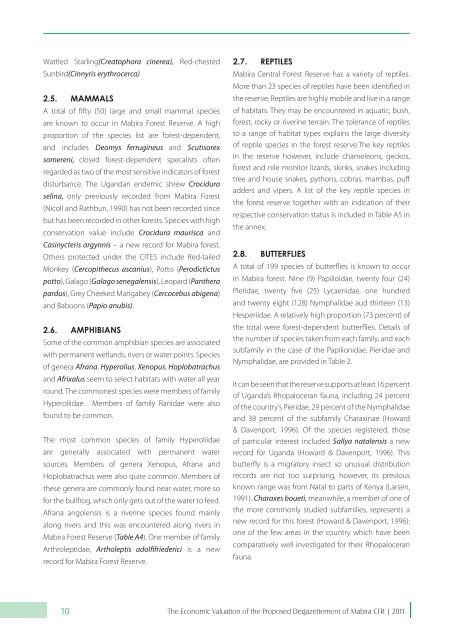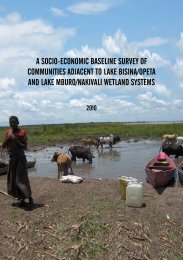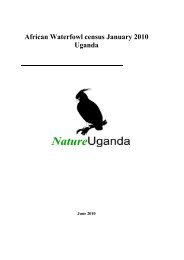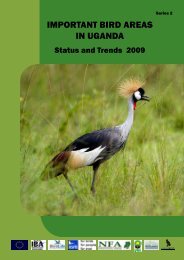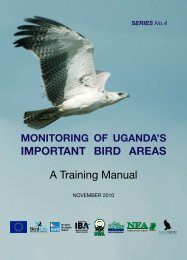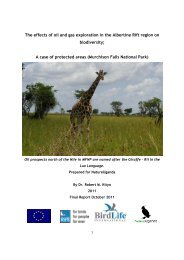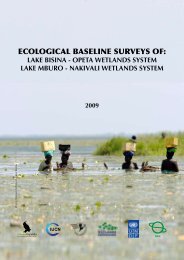the economic valuation of the proposed ... - Nature Uganda
the economic valuation of the proposed ... - Nature Uganda
the economic valuation of the proposed ... - Nature Uganda
You also want an ePaper? Increase the reach of your titles
YUMPU automatically turns print PDFs into web optimized ePapers that Google loves.
Wattled Starling(Creatophora cinerea), Red-chested<br />
Sunbird(Cinnyris erythrocerca)<br />
2.5. MAMMALS<br />
A total <strong>of</strong> fifty (50) large and small mammal species<br />
are known to occur in Mabira Forest Reserve. A high<br />
proportion <strong>of</strong> <strong>the</strong> species list are forest-dependent,<br />
and includes Deomys ferrugineus and Scutisorex<br />
somereni, closed forest-dependent specalists <strong>of</strong>ten<br />
regarded as two <strong>of</strong> <strong>the</strong> most sensitive indicators <strong>of</strong> forest<br />
disturbance. The <strong>Uganda</strong>n endemic shrew Crocidura<br />
selina, only previously recorded from Mabira Forest<br />
(Nicoll and Rathbun, 1990) has not been recorded since<br />
but has been recorded in o<strong>the</strong>r forests. Species with high<br />
conservation value include Crocidura maurisca and<br />
Casinycteris argynnis – a new record for Mabira forest.<br />
O<strong>the</strong>rs protected under <strong>the</strong> CITES include Red-tailed<br />
Monkey (Cercopi<strong>the</strong>cus ascanius), Potto (Perodictictus<br />
potto), Galago (Galago senegalensis), Leopard (Pan<strong>the</strong>ra<br />
pardus), Grey Cheeked Mangabey (Cercocebus abigena)<br />
and Baboons (Papio anubis).<br />
2.6. AMPHIBIANS<br />
Some <strong>of</strong> <strong>the</strong> common amphibian species are associated<br />
with permanent wetlands, rivers or water points. Species<br />
<strong>of</strong> genera Afrana, Hyperolius, Xenopus, Hoplobatrachus<br />
and Afrixalus seem to select habitats with water all year<br />
round. The commonest species were members <strong>of</strong> family<br />
Hyperoliidae. Members <strong>of</strong> family Ranidae were also<br />
found to be common.<br />
The most common species <strong>of</strong> family Hyperoliidae<br />
are generally associated with permanent water<br />
sources. Members <strong>of</strong> genera Xenopus, Afrana and<br />
Hoplobatrachus were also quite common. Members <strong>of</strong><br />
<strong>the</strong>se genera are commonly found near water, more so<br />
for <strong>the</strong> bullfrog, which only gets out <strong>of</strong> <strong>the</strong> water to feed.<br />
Afrana angolensis is a riverine species found mainly<br />
along rivers and this was encountered along rivers in<br />
Mabira Forest Reserve (Table A4). One member <strong>of</strong> family<br />
Arthroleptidae, Artholeptis adolfifriederici is a new<br />
record for Mabira Forest Reserve.<br />
10<br />
2.7. REPTILES<br />
Mabira Central Forest Reserve has a variety <strong>of</strong> reptiles.<br />
More than 23 species <strong>of</strong> reptiles have been identified in<br />
<strong>the</strong> reserve. Reptiles are highly mobile and live in a range<br />
<strong>of</strong> habitats. They may be encountered in aquatic, bush,<br />
forest, rocky or riverine terrain. The tolerance <strong>of</strong> reptiles<br />
to a range <strong>of</strong> habitat types explains <strong>the</strong> large diversity<br />
<strong>of</strong> reptile species in <strong>the</strong> forest reserve.The key reptiles<br />
in <strong>the</strong> reserve however, include chameleons, geckos,<br />
forest and nile monitor lizards, skinks, snakes including<br />
tree and house snakes, pythons, cobras, mambas, puff<br />
adders and vipers. A list <strong>of</strong> <strong>the</strong> key reptile species in<br />
<strong>the</strong> forest reserve toge<strong>the</strong>r with an indication <strong>of</strong> <strong>the</strong>ir<br />
respective conservation status is included in Table A5 in<br />
<strong>the</strong> annex.<br />
2.8. BUTTERFLIES<br />
A total <strong>of</strong> 199 species <strong>of</strong> butterflies is known to occur<br />
in Mabira forest. Nine (9) Papilioidae, twenty four (24)<br />
Pieridae, twenty five (25) Lycaenidae, one hundred<br />
and twenty eight (128) Nymphalidae aud thirteen (13)<br />
Hesperiidae. A relatively high proportion (73 percent) <strong>of</strong><br />
<strong>the</strong> total were forest-dependent butterflies. Details <strong>of</strong><br />
<strong>the</strong> number <strong>of</strong> species taken from each family, and each<br />
subfamily in <strong>the</strong> case <strong>of</strong> <strong>the</strong> Papilionidae, Pieridae and<br />
Nymphalidae, are provided in Table 2.<br />
It can be seen that <strong>the</strong> reserve supports at least 16 percent<br />
<strong>of</strong> <strong>Uganda</strong>’s Rhopaloceran fauna, including 24 percent<br />
<strong>of</strong> <strong>the</strong> country’s Pieridae, 29 percent <strong>of</strong> <strong>the</strong> Nymphalidae<br />
and 38 percent <strong>of</strong> <strong>the</strong> subfamily Charaxinae (Howard<br />
& Davenport, 1996). Of <strong>the</strong> species registered, those<br />
<strong>of</strong> particular interest included Sallya natalensis a new<br />
record for <strong>Uganda</strong> (Howard & Davenport, 1996). This<br />
butterfly is a migratory insect so unusual distribution<br />
records are not too surprising, however, its previous<br />
known range was from Natal to parts <strong>of</strong> Kenya (Larsen,<br />
1991). Charaxes boueti, meanwhile, a member <strong>of</strong> one <strong>of</strong><br />
<strong>the</strong> more commonly studied subfamilies, represents a<br />
new record for this forest (Howard & Davenport, 1996):<br />
one <strong>of</strong> <strong>the</strong> few areas in <strong>the</strong> country which have been<br />
comparatively well investigated for <strong>the</strong>ir Rhopaloceran<br />
fauna.<br />
The Economic Valuation <strong>of</strong> <strong>the</strong> Proposed Degazettement <strong>of</strong> Mabira CFR | 2011


